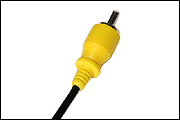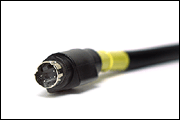Older televisions have some sort of video input--even if it's just a radio-frequency (RF) jack that you plug your rabbit-ear antenna into. These days, you'll almost always find a composite-video jack (usually color-coded yellow) and S-Video support, as well. The latest development is called component video. You'll find this connector, usually as a set of three RCA plugs (color-coded red, blue, and green), on everything from new mid-priced TVs to the most expensive HDTVs. It delivers the best picture yet in terms of resolution and color accuracy.
Now, let's explain what you'll find on the back of your TV.
In order to transmit a color TV show to your home, a station must combine the audio and the composite video channels, which it broadcasts as an RF signal. Then your TV has to separate the sound and the picture so that you can view your show. However, you'll get cleaner pictures and sound if you don't combine the signals. And that's why you find separate audio and composite-video cables on most VCRs, satellite boxes, and video game consoles.
Although the composite-video system was developed for color-TV signals, it doesn't give you a very sharp picture. Composite video was created as a backward-compatible solution for television's transition from black and white to color. It was a fairly clever solution to the problem of how to continue to send the same black-and-white picture to all the old sets and layer color information on top--a composite of those two picture components. The black-and-white sets ignored the color component, while the newer sets separated out the color information and displayed it with the black-and-white picture. This made for a smooth TV transition in the 1950s with low-resolution color TVs. Today, though, sophisticated high-resolution displays show all of the compression artifacts and cross-color (or moiré) blurring that comes with a composite video connection. It's simply impossible to perfectly separate the color and picture information of a composite-video signal. So, if your TV picture isn't sharp enough or the colors blur together, the likely culprit is a composite output signal.

Composite-video cable
S-Video, which was introduced in the 1980s, solved some of the problems that came with composite video. It provides better color separation and a much cleaner signal. S-Video does so by keeping separate the color and picture parts of a composite-video signal. You'll find S-Video ports on most TVs for sale today, but not many people are really taking advantage of them yet.

S-Video cable
Component video improves the picture quality even more by not only separating the color from the black-and-white portions of the picture but by further splitting the color information into two color-difference signals. When the picture signal is split up in this way, you get an unfiltered, uninterrupted image, with better resolution and greatly improved color saturation. And this is why component video is the predominant method of hookup from HDTV set-top decoders to HDTVs. (For a very technical explanation of color television and component video, see Tektronix's Web site.) This separation is most frequently labeled Y, Cb, and Cr for DVD players and other standard video sources. HDTV sources can display a wider color palette, and their component video connectors are labeled Y, Pb, and Pr to differentiate them. However, we've found that many manufacturers mislabel their component-video connectors. For example, some analog Sony TVs have jacks labeled Y, Pb, and Pr, but they cannot accept HDTV signals. The most common connection from DVD players is three RCA-type jacks.
Best pictures: DVD and HDTV sources are the best examples of the high-bandwidth, low-noise, and deeply saturated color that component video is capable of producing. The bigger the size of the screen and the higher the resolution of the display, the more evident the enhanced picture quality using component video. On small direct-view analog TVs, for example, you'll be hard-pressed to see a difference between an S-Video and a component-video connection from a DVD player. On higher-resolution, HDTV-capable direct-view and rear-projection TVs, though, the distinction becomes much more obvious.
On higher-end HDTV-ready sets,
progressive-scan
DVD players deliver the best possible DVD picture. As you may have guessed,
progressive-scan DVD is delivered via component-video outputs from a
progressive-scan-capable DVD player. Progressive scan adds even more resolution
and detail to the picture, as well as the enhanced color resolution inherent in
a component video signal.

Component-video cable
If you are in the market for a home-theater system, make sure to get a TV with component-video inputs--either a new-generation, HDTV-capable set or just a big-screen analog set. Virtually all HDTV-capable sets have component-video inputs. Many of today's HDTV-compatible sets have only one high-bandwidth (broadband, 480p, or 1,080i compatible) component input for the HDTV set-top box. A set with two broadband component-video inputs gives you greater flexibility, as it will allow you to simultaneously hook up a progressive-scan DVD player and an HDTV set-top box, thus eliminating the need for an expensive component-video switcher.